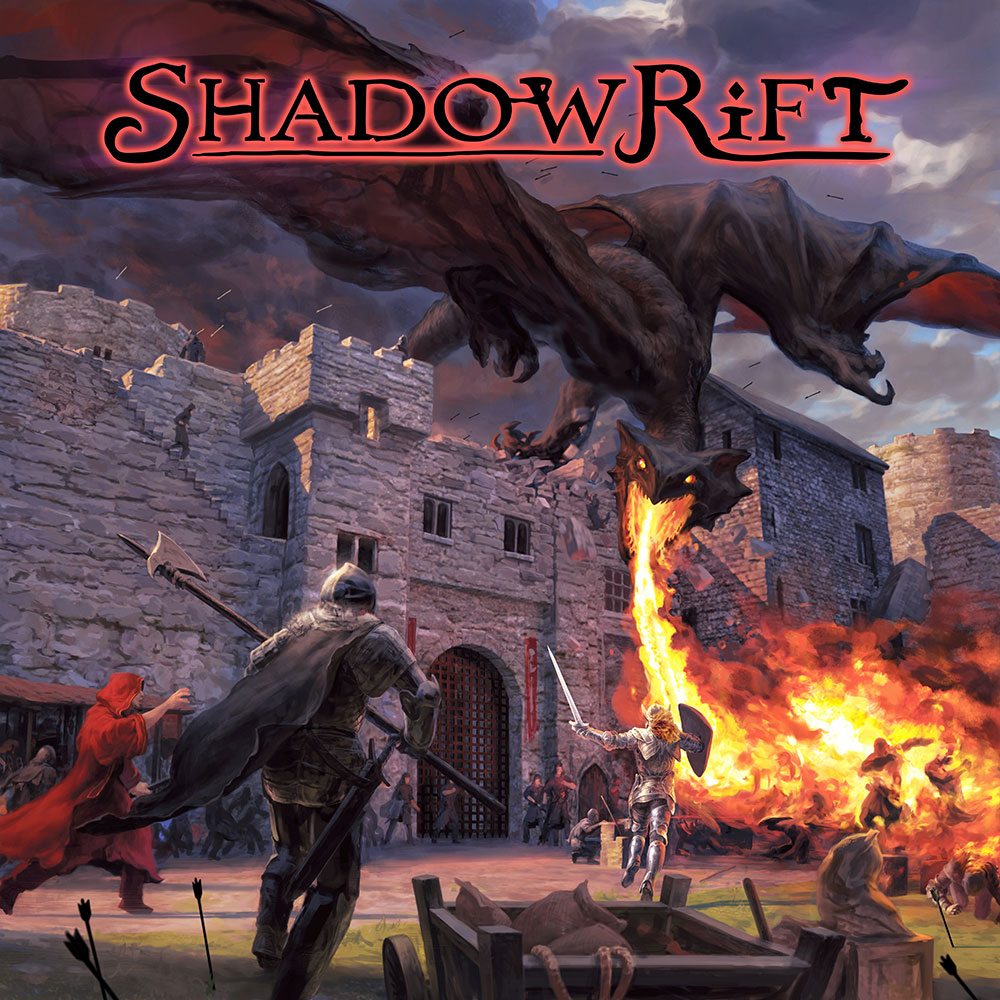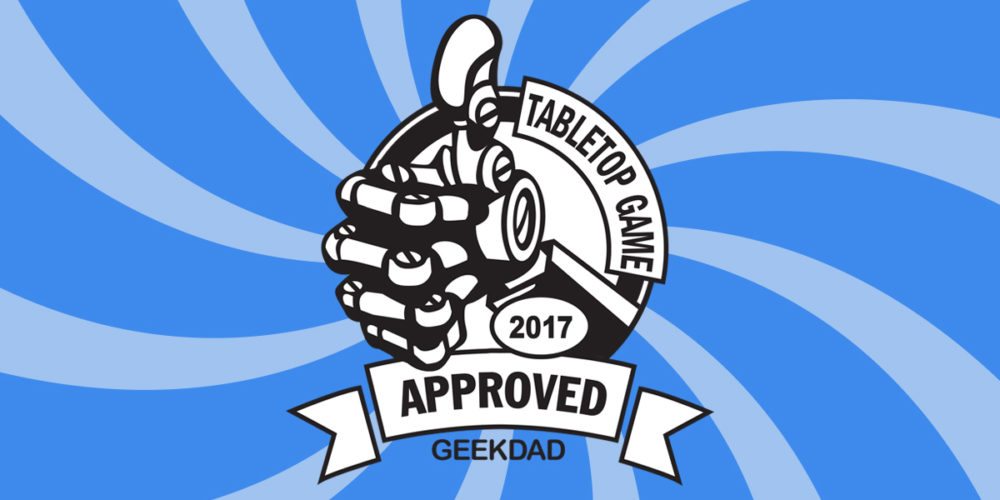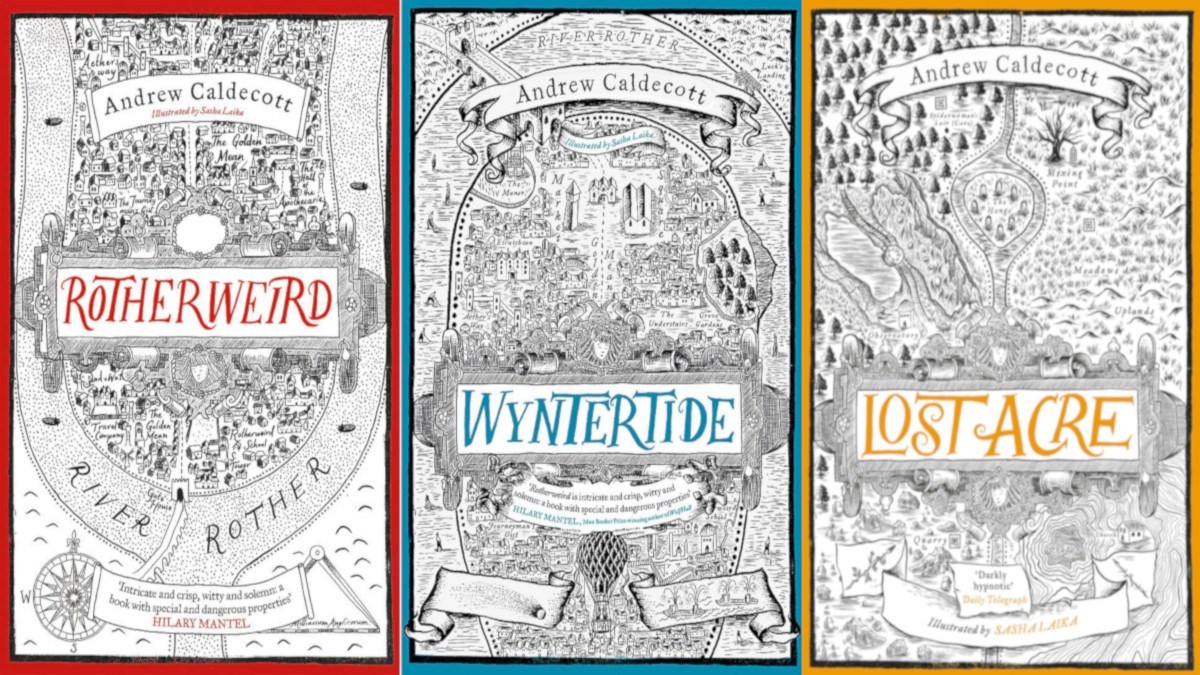Five years ago, I reviewed a cooperative deck-building game called Shadowrift, which made it onto my Best Games of 2012 list. The game wasn’t perfect, but it was still a fantastic experience and became my favorite deck-building game at the time. In 2015, Game Salute Kickstarted a 2nd edition, which was delivered to backers this past winter and is in stores now. I received a review copy recently and I’m thrilled to report that Shadowrift is better than ever.
At a glance: Shadowrift is a game by Jeremy K. Anderson for 1 to 6 players, ages 14 and up, and takes 45–120 minutes to play (depending on player count… and whether you die horribly before your time). It retails for $60 and is available directly from Game Salute, from online retailers like Amazon, or check your local game store. The game is a cooperative deck-building game, so if your kids are familiar with deck-building I think you could play with younger kids, though it is a little more complex than something like Dominion or Clank!. I’ve played with my 10-year-old and 13-year-old and they both enjoyed it, though they don’t want to play with the zombie-themed set.
Shadowrift is GeekDad Approved!

Components
Here’s what comes in the box:
- 284 Player Cards:
- 60 Starter cards
- 8 Might cards
- 8 Strike cards
- 4 Seal cards
- 30 Heroism cards
- 144 Hero cards (Loot, Attacks, Skills, and Actions)
- 40 Wounds
- 47 Town Cards:
- 24 Villagers (10 Starting, 14 Travelers)
- 8 Walls
- 15 Corpses
- 70 Monster Cards:
- 20 Monster cards in six factions
- 44 Special Monster cards (Burns, Zombies, Cultists, Tempests, Freezes, and Totems)
- 6 Shadowrifts
- 30 Randomizer Cards
- 1 Game board
- 8 Coin tokens
- 15 1-point tokens
- 6 5-point tokens
- 1 Next Heroism token and stand
- 17 card dividers
- 4 Monster Space markers
It’s a deck-building game, so unsurprisingly it’s a whole lot of cards, plus some other components.

The cards themselves are mostly an improvement over the original, which used a non-standard card size that was smaller and longer. These feel more like regular cards and shuffle well. The artwork is a mix of old and new—some cards feature the same artwork as the first edition, and others have gotten replaced. Overall the cards have a more consistent style, and some of the more cartoony illustrations have been redone. I also think the card design is a bit nicer and looks more professional, though there are a few cards that stand out as quite boring, like the Prowess, Heroism, and Might. At least now the Might card has a different colored background so it’s easier to distinguish from Prowess. The card backs aren’t very exciting—just black cards with the logo on them in different colors, depending on which deck they go in.
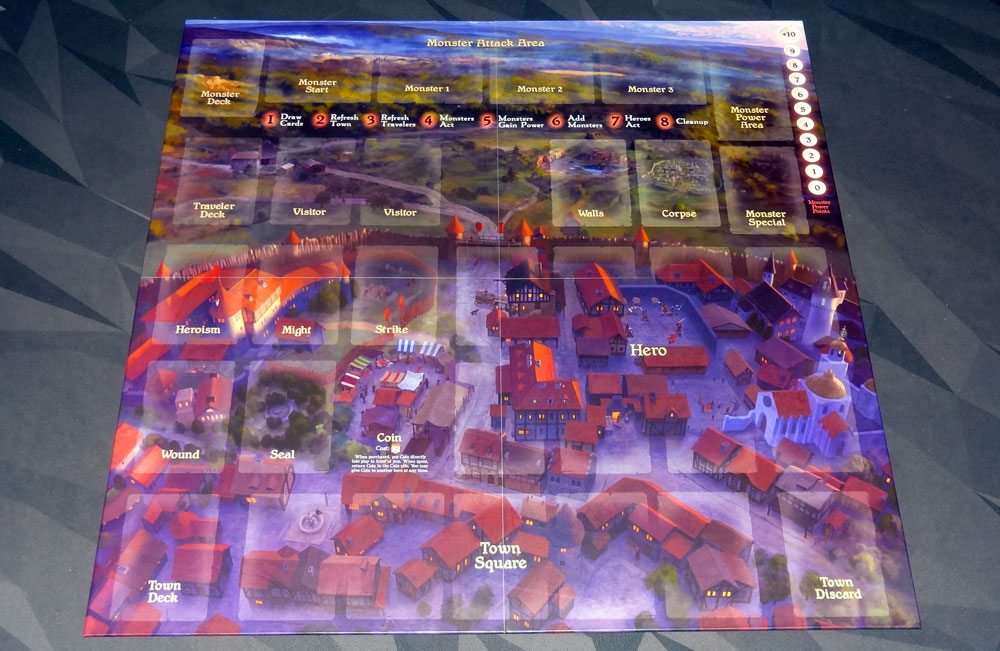
The second edition adds in a game board to help organize the cards. (There were options on the Kickstarter campaign to get the game without the board, but if you’re purchasing it now, it will be the deluxe version with the board included.) I’ve found that many of the earlier deck-building games didn’t have boards at first, but now it seems more common to have a board or playmat, which helps you get the game set up more smoothly and keeps things organized. The board also has the phases of each round printed across, so that it’s easy to keep track of every step of the game—as long as you remember to follow it. The monster space markers are used if you are playing without the board, and could be pretty handy if I want to travel with a selection of the cards and don’t want to bring the entire box. (The first edition had four cards for the monster spaces instead of the cardboard tokens.)
The board has an illustration that puts all of the various card decks in thematically appropriate places: all of your cards that you can add to your deck are in town, with things like a market where the pile of coins goes and a soldier training ground where the Strike cards go. The Corpse cards are placed in a cemetery, and the Travelers appear on a road outside of town. Monsters march across the top of the board, in the forests outside of town. The only thing is that it separates some of the cards from the decks where they’ll be placed—Travelers, Walls, and Corpses all go into the Town discard pile, but there’s a big area that separates them from each other. It might have been nice to have the Town row right next to the others, but thematically I suppose it wouldn’t make as much sense.

The Next Heroism token is a huge cardboard standee that looks like a flaming shield, and it has a plastic base to stand it up. This is compared to a small plastic pawn in the first edition. It’s pretty obvious and hard to miss, which I suppose is the point. Also new in this edition are the coin tokens (cardboard, unless you got the Kickstarter bonus, which had real metal coins, too). This is handy, because the first edition had coins just printed on cards, and it was easy to forget and shuffle those into your deck. Now it’s impossible to make that mistake.
The 1-point tokens and 5-point tokens are small cardboard circles; one side has a moon illustration and the other has a sort of droplet look to it. I think the idea is that you use the droplets for wounds on monsters, and the moons for tracking monster power on the monster power track, which looks like a series of moons. My only criticism is that because the icons are already full moons and the shadow on the crescent moon isn’t very dark, the small token can get lost visually.
The card dividers break up the cards into categories, but not necessarily into specific sections. For instance, there’s a “Basic Cards” divider for Might, Strike, Seal, and Corpses, which are used in every game—but so are Walls, Wounds, Heroism, and Villagers, and each of those gets its own divider. There are several types each of Loot, Attacks, Skills, and Actions, but the dividers lump them together, so you’ll just have to pick them out when you’re setting up.

The box is one of Game Salute’s standard large square boxes, with a cardboard divider that makes two “wells” for the cards. You’ll be able to fit all of the cards from the base game in only one side, but since there are already two expansions available and a third on the way, I appreciate the room for expansion. Plus, the board takes up the entire square, so the box couldn’t really be any smaller.

How to Play
You can download a copy of the rulebook here.
Since the game is fairly involved and I’ve already had a detailed explanation in my review of the original, I’ll just give a high-level overview here and note the differences in the second edition. Shadowrift is a deck-building game, which means that each player has their own deck of cards and their own discard pile. As you play, you will add cards to your own system, but each player is building up their own deck from a pool of available cards.

The goal of the game is to save New Haven, either by sealing all of the Shadowrifts or by building all 8 walls, turning New Haven into a fortress. (Presumably, once you’ve done that, the town can deal with the monsters that have already escaped from the Shadowrifts and are tearing through town.)
This being a cooperative game, there are several ways to lose:
- You have no villagers or walls at the start of the Heroes Act step.
- The last Corpse card is added to your city.
- A monster takes the Annihilation action and destroys the world.
You’ll always choose one of 6 monster types to battle, and you can use either the recommended cards for the hero cards, or choose your own, or use the randomizer cards to mix things up. Each game includes some basics: Might, Strike, and Seal, plus the coin tokens; you then add 8 more card types consisting of Actions, Attacks, Skills, and Loot. You’ll also have a stack of Heroism cards, Walls, Wounds, and Corpses. The monster deck will have one Shadowrift per player shuffled into it. Each player starts with a set of the same ten cards: 7 Prowess, 2 Strike, and 1 Explore. Finally, there are two decks for the villagers: the town deck with the 10 starting villagers and the deck of Travelers.
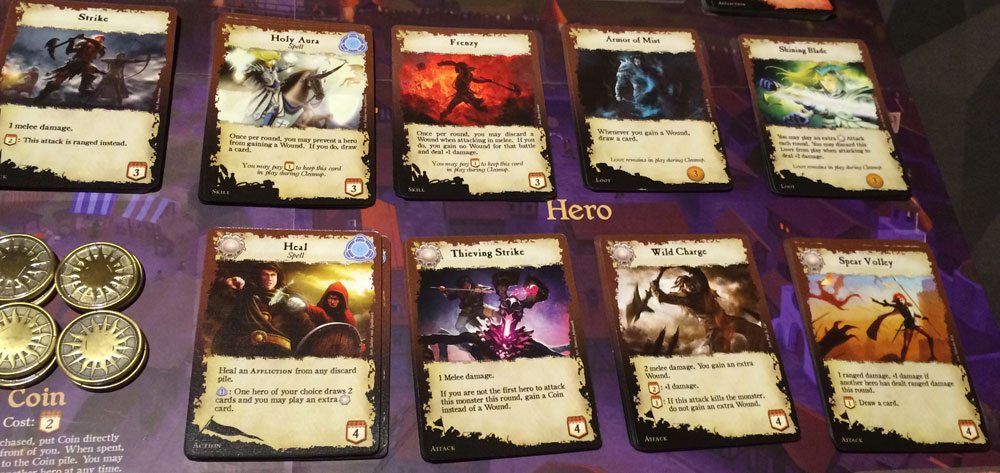
The three basic resources in the game are Prowess, Magic, and Coins. Most cards require Prowess to purchase, and it cannot be shared. Any card that has the Magic symbol on it can be spent as Magic or played for the card’s effect, but not both. Coins, unlike money in most deck-building games, are not part of your deck. They’re placed in front of you, and can be given to another hero at any time—and each Coin can only be spent once, at which time it is returned to the Coin stack.
Each round consists of the following phases. It’s important to refer to the turn order reminder on the board, because even now, I still find myself skipping steps 5 and 6 and having to back up the player’s actions to do those.
- Draw Cards – Draw 5 cards from your deck. Might and Heroism cards let you draw extra cards.
- Refresh Town – Discard town cards and draw 5 new cards.
- Refresh Travelers – Discard travelers and draw 2 more. Infiltrators go directly to the town discard pile.
- Monsters Act – Monsters march across the board, performing the actions according to what space they’re in. They may kill villagers or cause other nasty effects. If a monster takes an action that says “Annihilate,” you lose the game. Monsters that leave the third space go into the Monster Power Area and no longer act, but instead add power each turn.
- Monsters Gain Power – Add 1 monster power per player, plus 1 power per symbol on the cards in the Monster Power Area.
- Add Monsters – Spend monster power to put into play as many cards from the top of the monster deck as you can afford.
- Heroes Act – You finally get your turn! Maybe. (See below.)
- Cleanup – Discard everything that you’ve played and left in your hand except for cards that remain in play. Loot cards can stay in play, and Skill cards can stay in play if you spent 1 Prowess to maintain them.

Heroes Act: This is where you finally get to take action… assuming your town is still worth defending. If there are no Walls or Villagers (not Infiltrators) in play at this time, you have lost the game.
One difference between Shadowrift and many other cooperative games is that everyone can take their actions in any order; you don’t have to take turns. In fact, it’s usually much more beneficial if you discuss your plan of action because some abilities will depend on who attacked first.
You’ve got several options: buy cards/coins from town, play actions and attacks, hire travelers to come to your town, or seek aid from the villagers who are currently in play in town. Unlike the first edition, you can seek aid from as many villagers as you want, though each villager can only be used once per round.
Playing actions is straightforward: you play the card and do what it says. Some cards can be boosted with Prowess or Magic or Coins to have additional effects. Cards marked with a white starburst icon are Epic Actions or Attacks. You may only play one of these per round (unless you have an ability that says otherwise), but you may play as many of the other cards as you want. (In first edition, there were Quick Actions and Regular Actions and you could only play one Regular Action. It’s basically the same effect but with different terminology.)
Killing monsters puts them back on the bottom of the monster deck and earns the team Heroism cards, which will be distributed among the entire party as evenly as possible. The big Next Heroism token is passed around to remind you who gets the next Heroism card.
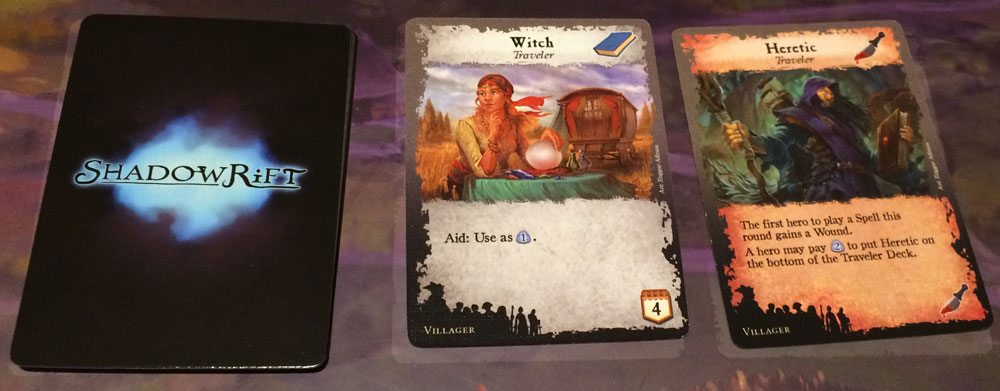
If you build Walls or hire Travelers, they go into your town discard pile, so they’ll show up back in town eventually. Villagers who die from monster attacks go back into the Traveler deck, so eventually you’ll be able to hire new Guards to replace the old ones, and so forth.
A few other notes: whenever you play melee attacks on a monster, you will take a Wound—but it’s limited to a single Wound per monster no matter how many melee attacks you play on that monster. Your basic Strike card is a melee attack, but you can also pay 2 Prowess to turn it into a ranged attack to avoid the Wound. Wounds basically dilute your deck, taking up space in your hand, but there are some skills (like Frenzy) that let you use Wounds for beneficial effects. You can remove Wounds by paying 2 Prowess, or with certain other card effects.
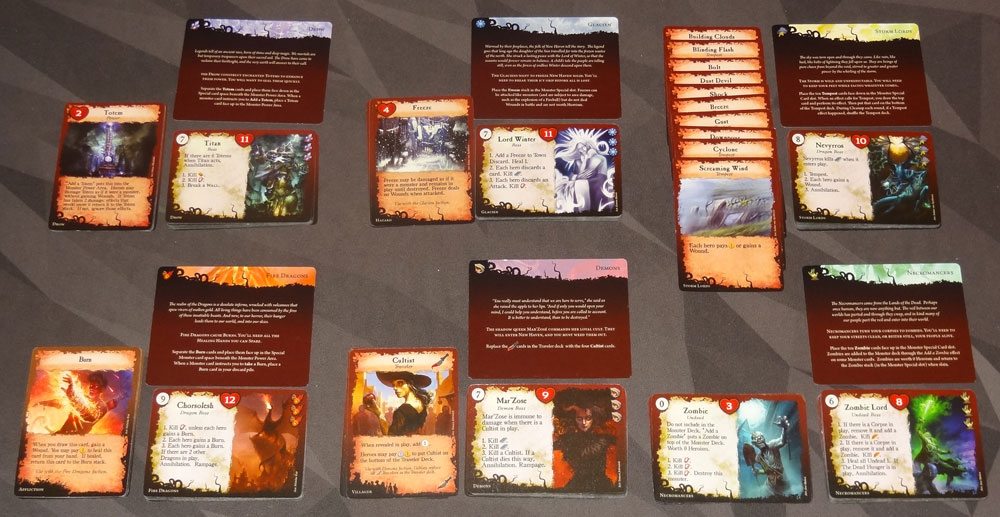
The six monster types included in the game each have their own strengths and types of attack:
- Demons: Cultists come to town to help the Demons spawn more quickly or give them more power.
- Fire Dragons: Dragons cause Burns — and each time you draw a Burn card, you get another Wound. Very bad.
- Glacien: Your town will fill up with Freezes, which are not discarded from town until you smash them.
- Drow: Drow build Totems, which build up their power and boost their abilities.
- Necromancers: Corpses turn into Zombies, which quickly add more Corpses to your Town, which turn into Zombies … you get the picture.
- Storm Lords: Special Tempest cards will cause unpredictable effects.
For the most part, the game rules are the same as the first edition, with a few tweaks here and there mostly to terminology. One significant change is that Might cards, which are worth 1 Prowess and let you immediately draw another card, are returned to the supply if you use them to purchase something. If you spend Might to maintain a skill, it goes in your discard pile, but otherwise it’s a one-time use. I haven’t compared all of the cards side by side to see if all of the monster powers and hero abilities are exactly the same, but most of it feels familiar.
The Verdict
Because I’m usually playing games I need to review these days, I rarely spend time playing older games, even those I considered my favorites, so it had been a while since I last played Shadowrift. So I was really excited to get the second edition, because it gave me an excuse to dive back into the world of New Haven, which apparently replaced the original Haven Town—I assume it was overrun by zombies, or froze over from the Glacien, or was burned down by dragons. Playing it again, I remember how much I enjoyed Shadowrift the first time around, and in less than a month it has already gotten 11 plays.
The things I liked about it the first time around have stood the test of time. The cooperative play where you all get to take your turns together still feels innovative. There’s less downtime, more strategic planning, and more possibilities than in some other cooperative games where you have to wait until it’s your turn to act… by which time maybe it’s too late. I still really like the way the monsters march across the board, triggering different effects as they enter each space. I love the tension you get flipping over town cards to see whether you’ve got any living souls left.

The game forces you to make tough decisions: do I make my Strike ranged so I avoid a wound? Or do I spend that Prowess on something else instead, hoping that buying a good card will overcome that wound? Should we build a wall or hire a traveler? Or just get some more attacks? If we don’t have enough attacks to kill off both of these monsters, which one do we let get away for another round? Do you try to seal the Shadowrifts, or build walls?
I’ve played with all of the different monsters again, and I love the way that they feel so different from each other because of the way that their powers work. The strategy that worked with one of them may not work with another.
But, most importantly: it’s fun. When you play, you can feel a story playing out, though you don’t know whether it’ll have a happy ending until you finish. Or a gruesome ending, like the time we technically saved New Haven—all that was left was a Gravedigger, a few walls, and a town full of corpses. At least he had job security, I guess. Win or lose, I always have a good time playing Shadowrift.
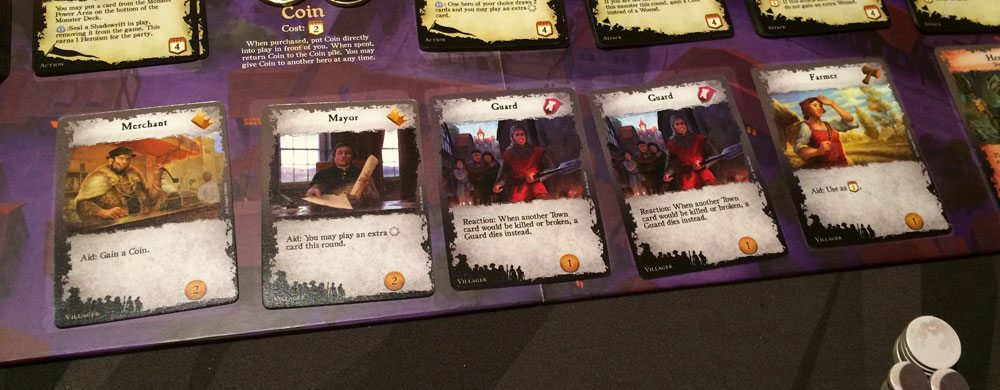
I do have to confess that I missed a significant rule in the first edition, and only learned it this time around. I knew that you lost the game if you didn’t have any walls or villagers in town, but I thought that was at the beginning of the round, when you refreshed the town. In fact, it’s at the beginning of your turn, in phase 7 when the heroes act. So if you have living villagers but then they get killed by monsters, the game is over. I’m going to have to put asterisks next to several of my “victories” now, and the game just got a little bit harder, but I’m up for the challenge.
The changes from the original version are mostly cosmetic, but I really like having the board to help keep everything organized, and the deluxe metal coins are really satisfying. (If you get the cardboard coins, they won’t have the nice clink, but they still prevent you from accidentally shuffling coins into your deck.) All in all, I’m happy to say that Shadowrift has withstood the test of time… even if Haven Town didn’t.
If you like deck-building games and you’ve never tried Shadowrift, I highly recommend it. And if you’re a fan of Legendary, another popular cooperative deck-building game, I think there are enough differences that there’s room in your collection for both.
Disclosure: I received a review copy of this game.

